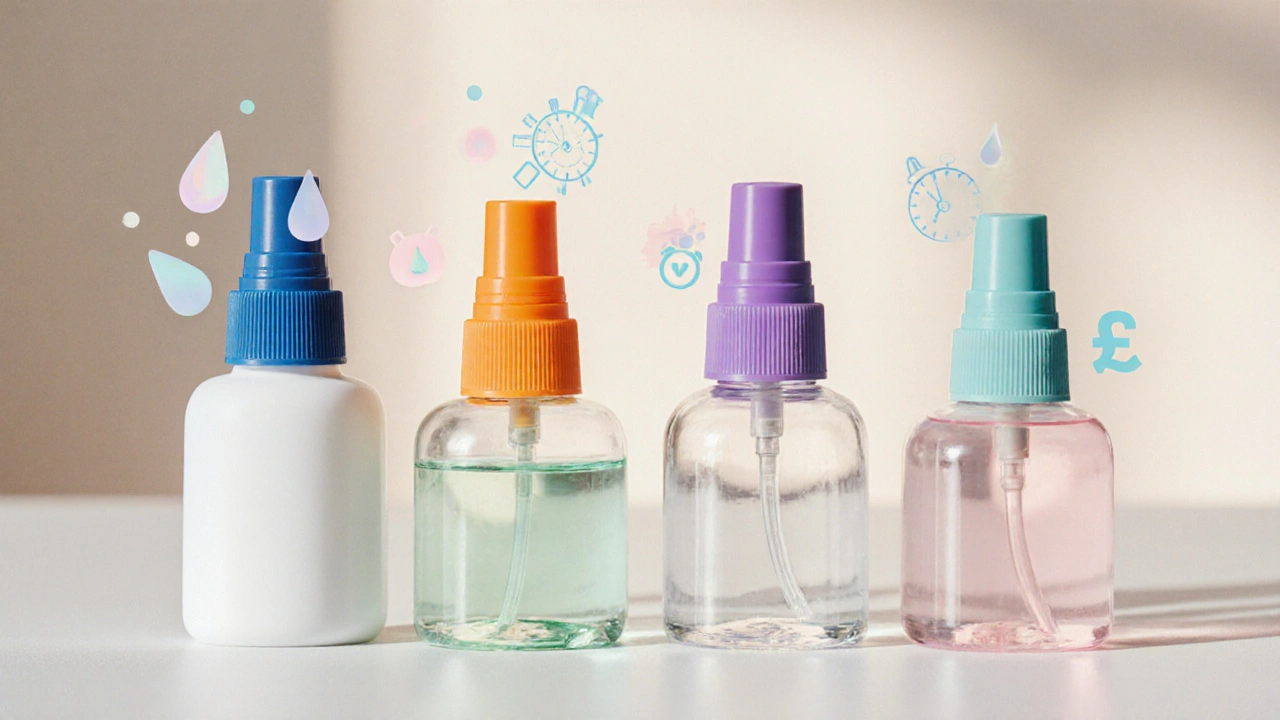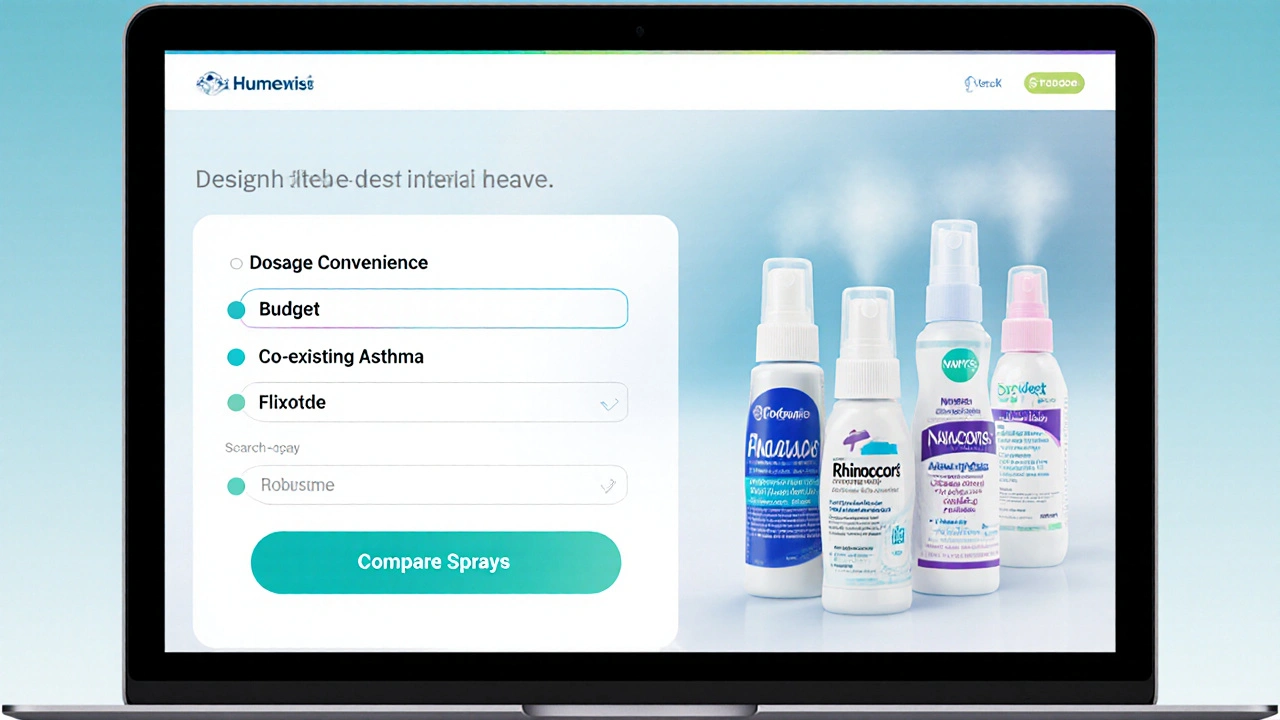Nasal Spray Decision Helper
Use this tool to compare nasal sprays based on your priorities. Select your top 3 criteria from the list below, then click "Compare Sprays" to see which one fits best.
Recommended Spray for You
Detailed Comparison
| Attribute | Flixotide | Nasacort | Rhinocort | Avamys |
|---|---|---|---|---|
| Dose per spray | 50 µg | 45 µg | 50 µg | 27.5 µg |
| Daily dose limit | 200 µg (4 sprays) | 200 µg (5 sprays) | 200 µg (4 sprays) | 55 µg (2 sprays) |
| Onset of action | 2-4 hours | 3-5 hours | 4-6 hours | Within minutes |
| Price (NHS + private) | £12 - £18 (generic) / £27 (brand) | £9 - £14 | £10 - £16 | £13 - £20 |
| Common side effects | Nasal irritation, thrush (5-12%) | Nasal dryness, mild bleed (6-10%) | Dryness, headache (5-9%) | Irritation, taste change (4-8%) |
When you need fast relief from hay fever or chronic nasal congestion, the spray you pick can shape how quickly symptoms melt away and how many side‑effects you endure. Flixotide Nasal Spray is a 100‑dose nasal spray containing fluticasone propionate, a prescription‑only corticosteroid used to treat allergic rhinitis and nasal polyps. It’s popular in the UK, but a handful of other sprays promise similar benefits at different price points or dosing schedules. This guide lines up Flixotide against the most common alternatives, demystifies the key differences, and gives you a clear path to the right choice for your nose.
Key Takeaways
- Flixotide delivers 50µg of fluticasone propionate per spray; most alternatives hover around 45‑55µg.
- All four products are prescription‑only in England, but pricing varies from £7 (generic) to £27 (brand‑name).
- Onset of action is fastest with Avamys (within minutes) and slowest with Beclomethasone‑based sprays (up to a week).
- Side‑effects such as nasal irritation or thrush appear in 5‑15% of users, but proper technique lowers risk.
- Choosing the right spray hinges on dose convenience, cost, and any co‑existing asthma or COPD.
What Is Flixotide Nasal Spray?
Flixotide belongs to the class of fluticasone propionate, a synthetic glucocorticoid that mimics the body’s own cortisol to dampen inflammation inside the nasal passages. The 100‑dose cartridge supplies a measured 50µg per actuation, letting most adults stay within the 200µg daily ceiling recommended by the UK National Institute for Health and Care Excellence (NICE). Its bottle is child‑proof, and the spray nozzle is designed to give a fine mist that reaches the middle turbinate without dribbling.
How Flixotide Works
Once the spray lands on the nasal mucosa, fluticasone binds to intracellular glucocorticoid receptors, switching off genes that produce pro‑inflammatory cytokines. The result is reduced swelling, less mucus production, and a quicker return to normal breathing. Because the drug acts locally, systemic absorption is minimal-typically less than 2% of the dose reaches the bloodstream.
Common Alternatives on the UK Market
Most doctors prescribe a nasal corticosteroid rather than an oral antihistamine for persistent symptoms. Below are the four alternatives that regularly appear in NHS formularies.
- Nasacort - contains triamcinolone acetonide (45µg per spray). Available as a 120‑dose bottle, it’s usually recommended for children over 6.
- Rhinocort - delivers budesonide (50µg per spray). Its 60‑dose cartridge is marketed for adults with moderate‑to‑severe rhinitis.
- Avamys - uses fluticasone furoate (27.5µg per spray). Though the dose per actuation is lower, the newer molecule has a longer receptor‑binding time, allowing once‑daily use.
- Beclomethasone dipropionate - found in the brand‑name Beclovent, it supplies 50µg per spray but requires a twice‑daily regimen for full effect.
Side‑Effect Profile Across Sprays
Local irritation, dry nose, and epistaxis (nosebleeds) show up in roughly 5% of users, regardless of brand. Oral thrush is more common when the spray drips into the throat, which can be prevented by gently sniffing after each actuation. Systemic side‑effects such as adrenal suppression are rare at prescribed doses but become a concern if users exceed the daily limit.

Head‑to‑Head Comparison
| Attribute | Flixotide (Fluticasone) | Nasacort (Triamcinolone) | Rhinocort (Budesonide) | Avamys (Fluticasone Furoate) |
|---|---|---|---|---|
| Active ingredient | Fluticasone propionate | Triamcinolone acetonide | Budesonide | Fluticasone furoate |
| Dose per spray | 50µg | 45µg | 50µg | 27.5µg |
| Typical daily dose limit | 200µg (4 sprays) | 200µg (5 sprays) | 200µg (4 sprays) | 55µg (2 sprays) |
| Prescription status (England) | Prescription‑only | Prescription‑only | Prescription‑only | Prescription‑only |
| Price (NHS + private) | £12 - £18 (generic) / £27 (brand) | £9 - £14 | £10 - £16 | £13 - £20 |
| Onset of symptom relief | 2‑4hours | 3‑5hours | 4‑6hours | Within minutes |
| Common side‑effects | Nasal irritation, thrush (5‑12%) | Nasal dryness, mild bleed (6‑10%) | Dryness, headache (5‑9%) | Irritation, taste change (4‑8%) |
Decision Criteria: Which Spray Fits Your Life?
Instead of hunting for the cheapest label, line up the factors that really matter to you.
- Dosage convenience - If you hate counting sprays, Avamys’s low‑dose, once‑daily regimen may win.
- Budget - Generic Flixotide and Nasacort sit at the lower end of the price range, especially with NHS discounts.
- Co‑existing asthma - Budesonide (Rhinocort) also appears in inhaler form, making it a tidy choice for patients juggling both conditions.
- Age considerations - Nasacort is approved for kids as young as six, while Flixotide is typically prescribed to adults and older children.
- Speed of relief - For breakthrough symptoms, Avamys’s rapid onset can provide near‑instant comfort.
Write down the top three items that matter most, then match them to the column that ticks the most boxes. That simple scoring system removes the guesswork.
Practical Tips & Common Pitfalls
Even the best spray won’t work if you misuse it. Follow these steps each morning:
- Blow your nose gently to clear excess mucus.
- Shake the bottle for a few seconds - the suspension needs mixing.
- Hold the head slightly forward, insert the tip just inside the nostril, and aim the spray toward the outer side of the septum.
- Press down once, inhale gently through the nose, then close the other nostril and exhale through the mouth.
- Repeat in the opposite nostril if the regimen calls for two sprays per day.
Common errors include: pointing the nozzle straight up (which sends spray to the throat), using a forceful inhale (causing drip), and exceeding the daily limit to chase faster relief. All three raise the risk of nosebleeds and oral thrush.
When to See a Doctor
If symptoms persist beyond two weeks despite daily use, or if you develop persistent nosebleeds, facial pain, or visual disturbances, book an appointment. Those signs could indicate sinus infection, nasal polyps, or adverse reaction that needs specialist input.
Frequently Asked Questions
Can I use Flixotide without a prescription?
No. In England, Flixotide is classified as prescription‑only medicine, meaning you need a GP or respiratory specialist to issue it.
How long does it take for Flixotide to start working?
Most users notice reduced congestion within 2‑4hours, but full anti‑inflammatory effect may take up to a week of continuous use.
Is it safe to use Flixotide while pregnant?
Guidelines suggest using the lowest effective dose if needed. Discuss any nasal steroid with your obstetrician, as data on high‑dose exposure is limited.
Can I switch from Flixotide to Avamys?
Yes, but tapering isn’t usually required because both are low‑systemic steroids. Your GP should confirm the new daily limit (55µg for Avamys) and provide a new prescription.
Why do I get a sore throat after spraying?
A sore throat often means some spray is dripping into the throat. Try tilting your head slightly forward and gently sniffing rather than forcefully inhaling.
Next Steps
Grab a blank sheet, jot down your top three criteria from the decision list, and bring it to your next GP visit. Ask whether a generic Flixotide prescription is available, or if an alternative better matches your budget and dosing preferences. If you’re already on a nasal spray but still suffer, request a short trial of an alternative-most NHS practices will let you switch after a two‑week washout period.
Remember, consistency is key. Use the spray every day as directed, even on symptom‑free days, to keep inflammation at bay. With the right product in hand, you’ll breathe easier and ditch those endless tissue boxes.
